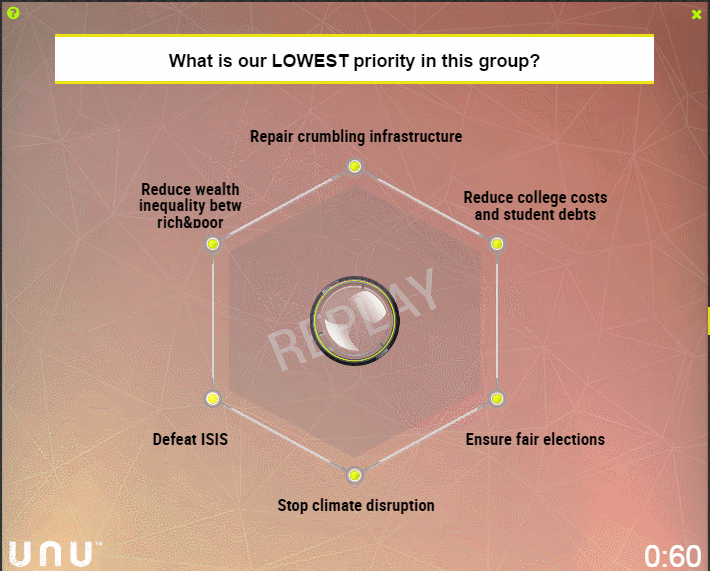Few tasks are more challenging for groups than the setting of priorities. In fact, priority-setting is among the most dreaded tasks for groups of all types, from corporate teams to political parties. And the more diverse the group, the more challenging it is to find common ground. Out of convenience, many organizations resort to votes, polls, and surveys as a means for gathering input and ordering priorities. This, however, does not necessarily achieve results that optimize satisfaction among the participating members.
To find a better way, researchers at Unanimous A.I. looked to Mother Nature. Natural groups do not take polls or run surveys – they form closed-loop systems called swarms that explore complex problems together, in real-time, and converge on optimal outcomes. And now, using Swarm Intelligence technology, human groups can form online swarms and achieve similar optimizations. Prior research into human swarming has shown that when online users combine their knowledge, insights, and opinions by working together in swarms, they can achieve optimized predictions and forecasts.
So, which is better for setting the priories of a group – taking a Poll or forming a Swarm? To answer this question, researchers at Unanimous A.I. assembled a diverse group of 43 voting-age Americans of mixed party affiliation and had them review a list of 24 popular issues that are being debated in the 2016 Presidential and Congressional campaigns. From that full list, participants were asked to identify and rank what they believed should be the top five priorities for the new President and Congress in 2017.
In the first phase of the study, each participant completed an online survey to identify and rank their top five priorities. In the second phase, the participants (using the UNU swarming platform) worked together to collectively rank their top 5 priorities as a unified intelligence. For those who are not familiar with swarming, it’s a real-time process where the group works together to answer questions synchronously, with feedback loops allowing the group to converge. Here is an example of the swarm of this study converging on one of the many answers they were asked to reach:
Based on the Survey and the Swarm, two sets of priorities were generated by the group. The priorities shown in LIST A (below) were produced by the group working together as a swarm. LIST B is the list of priorities produced from the survey results.
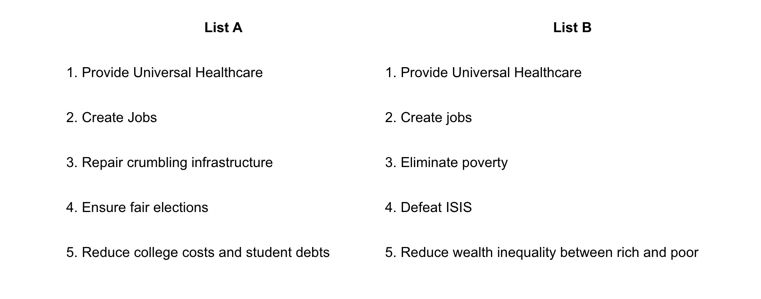
As shown above, the sets of top-five priorities from the swarm and the survey had significant similarities and important differences. The key similarity is that first and second priorities – Provide Universal Healthcare and Create Jobs – were the same for both sets. The key next three priorities, however, were completely different for the two methodologies.
It’s interesting to observe that priorities 3, 4 and 5 in List A (from the swarm) – Repair crumbling infrastructure, Ensure fair elections, and Reduce college costs and student debt – reflect issues of immediate and direct impact on respondents’ lives, while priorities 3, 4 and 5 in List B (from the survey) – Eliminate poverty, Defeat ISIS, and Reduce wealth inequality between rich and poor – are more abstract goals. In fact, respondents commented that they felt that issues such as “eliminating poverty” were not realistic goals. In answering the survey, respondents seemed to feel a need to express abstract altruistic goals. In contrast, participating in the swarm, where every ranking was a real-time exercise in group negotiation and compromise, evoked responses that seem more grounded and realistic.
One might wonder if surveys encourage people to answer the way “they think they’re supposed to” while swarms encourage groups to converge on answers that better reflect their true feelings. To explore this question, the 43 participants were asked to reflect on each set of priorities and indicate which set they believed better reflected their true feelings.
When asked which list best represented their priorities,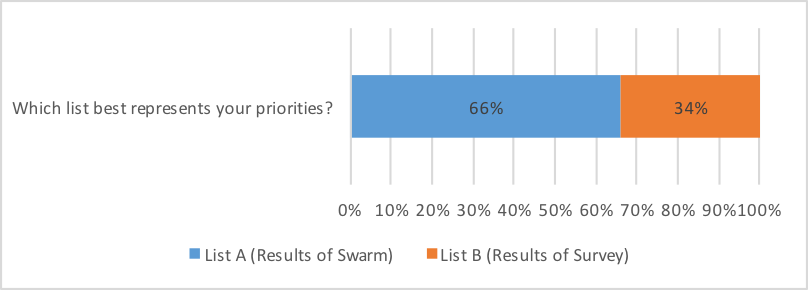 66% of the respondents favored the results of the swarm, compared with just a third that felt the survey results better reflected their priorities.
66% of the respondents favored the results of the swarm, compared with just a third that felt the survey results better reflected their priorities.
Participants were also asked to consider which process (swarm or survey) 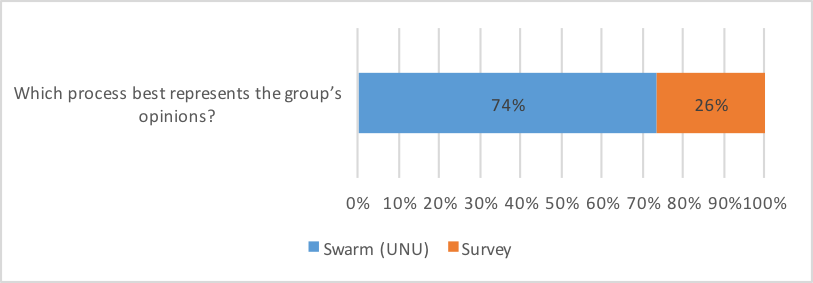
they found to better represent the group’s overall priorities. 74% indicated that the swarm better represented the priorities of the group.
Lastly, the participants were asked to reflect on the process itself – prioritizing by survey, or prioritizing by swarm – and indicate which method they found to be more enjoyable. 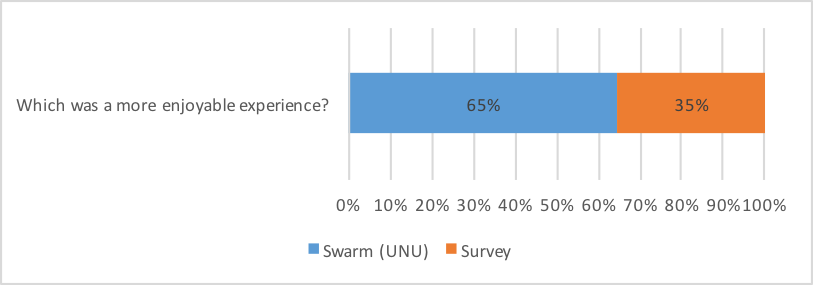 65% of the respondents found the swarming process to be more enjoyable.
65% of the respondents found the swarming process to be more enjoyable.
These results echo other research that
indicates that swarming is a more social, inclusive, and pleasant process than taking surveys. This is important for news organizations and researchers that are struggling to entice people to take part in surveys that are often perceived as boring and a waste of time.
Surveys and polls are widely used by business organizations, market researchers, and news outlets to gauge the sentiments of the public, but these instruments suffer from significant limitations. The results of this research suggests that swarms may be a more effective methodology for identifying priorities in diverse groups. Where surveys aggregate individual snapshots and highlight differences within groups, and possibly encourage abstract input, swarms immerse respondents in a group decision dynamic that results in clearer representations of their individual and collective opinions, in a way that is more enjoyable and more likely to get repeat engagements.
If you would like to try swarming by yourself or with your group or team, visit UNU at unu.ai.

